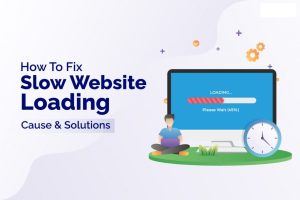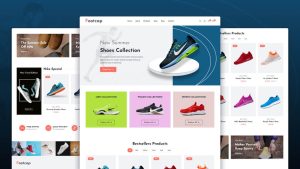Mind-Blowing E-commerce Website Design Secrets
Table of Contents
Introduction
In the fast-paced world of online retail, creating a visually appealing and user-friendly e-commerce website is crucial for attracting and retaining customers. A well-designed site not only enhances the user experience but also significantly boosts conversion rates. This comprehensive guide delves into the 10 secrets to designing a mind-blowing e-commerce website that captivates visitors and drives sales.
10 Secrets to Designing a Mind-Blowing E-commerce Website

Understanding Your Audience
To create an engaging e-commerce website, understanding your audience is paramount. This involves thorough research and the development of detailed personas that represent your target customers. By knowing their preferences, pain points, and behaviors, you can tailor the user experience to meet their specific needs.
Research and Personas
Begin by conducting market research to gather insights about your audience. Use surveys, interviews, and analytics data to understand their demographics, interests, and shopping habits. Developing personas, which are fictional representations of your ideal customers, can help you visualize their needs and preferences. These personas should include details like age, gender, occupation, and buying motivations.
Tailoring Experiences
With a clear understanding of your audience, you can personalize the shopping experience on your website. This might involve creating targeted marketing campaigns, personalized product recommendations, and customized content that resonates with different segments of your audience. By addressing their unique needs and preferences, you enhance user engagement and drive conversions.
User-Friendly Navigation
A seamless navigation system is essential for any e-commerce website. It helps users find what they are looking for quickly and efficiently, enhancing their overall shopping experience.
Simple and Intuitive Menus
Design your website’s menus to be simple and intuitive. Avoid overcrowded menus with too many categories. Instead, organize products into clear, logical categories and subcategories. Use dropdown menus to minimize clutter and help users easily navigate through different sections.
Search Functionality
Implement a robust search functionality that allows users to quickly find products. This should include autocomplete features, filters, and sorting options to refine search results. A well-designed search bar enhances usability and reduces the time users spend looking for specific items.
Breadcrumbs for Easy Navigation
Breadcrumbs are navigational aids that show users their current location within the website’s hierarchy. They help users understand their path and easily backtrack if needed. Including breadcrumbs improves site usability, especially for websites with extensive product catalogs.
Mobile Optimization
With the increasing use of smartphones for online shopping, ensuring your e-commerce website is mobile-friendly is more important than ever. A mobile-optimized site provides a seamless shopping experience across all devices.
Responsive Design Principles
Implement responsive design principles to ensure your website adjusts to different screen sizes and resolutions. This involves using flexible grids, images, and CSS media queries to create a layout that adapts to various devices, from desktops to smartphones.
Testing on Various Devices
Regularly test your website on different devices and browsers to ensure compatibility and performance. This helps identify any issues that may affect the user experience on specific devices. Use tools like Google’s Mobile-Friendly Test to evaluate your site’s mobile responsiveness.
Accelerated Mobile Pages (AMP)
Consider using Accelerated Mobile Pages (AMP) to improve mobile performance. AMP is an open-source framework that creates lightweight web pages that load quickly on mobile devices. Implementing AMP can significantly enhance your site’s speed and user experience on mobile.
High-Quality Visuals
Visual content plays a critical role in the perception and effectiveness of your e-commerce website. High-quality images and videos can captivate users and drive engagement.
Impact of Professional Photography
Invest in professional photography to showcase your products in the best light. High-resolution images that highlight product details can influence purchasing decisions. Use multiple angles and zoom features to give customers a comprehensive view of the products.
Use of Videos and Animations
Incorporate videos and animations to create a dynamic and engaging shopping experience. Product demonstration videos, customer testimonials, and interactive animations can provide valuable information and enhance user engagement. Ensure that these elements are optimized for fast loading and do not hinder site performance.
Consistent Branding
Maintain consistent branding across all visual elements of your website. This includes using a cohesive color scheme, typography, and imagery that aligns with your brand identity. Consistent branding helps build trust and recognition among your customers.
Fast Loading Times
Website speed is a crucial factor in user experience and SEO. Slow loading times can lead to higher bounce rates and lost sales opportunities.
Importance of Speed
Fast loading times are essential for keeping users engaged and reducing bounce rates. Studies show that even a one-second delay in page load time can result in significant drop-offs in user engagement and conversions.
Techniques to Improve Load Times
Optimize your website’s performance by minimizing HTTP requests, using browser caching, and compressing images. Implement content delivery networks (CDNs) to distribute your content across multiple servers and reduce load times for users around the world.
Tools for Monitoring Speed
Use tools like Google PageSpeed Insights, GTmetrix, and Pingdom to monitor and analyze your website’s speed. These tools provide insights into performance issues and recommendations for improvements. Regularly check your site’s speed to ensure optimal performance.
Compelling Product Descriptions
Product descriptions are essential for informing and persuading potential customers. Well-written descriptions can significantly impact purchasing decisions.
Writing for Persuasion
Craft product descriptions that highlight the features, benefits, and unique selling points of each product. Use persuasive language to create a sense of urgency and encourage conversions. Focus on addressing potential questions and concerns customers might have.
Incorporating SEO
Optimize product descriptions with relevant keywords to improve search engine visibility. Use natural language and avoid keyword stuffing. Include key information such as product specifications, materials, and dimensions to provide comprehensive details for search engines and users alike.
Utilizing User Reviews
Incorporate user reviews and testimonials in your product descriptions. Positive reviews build trust and credibility, while detailed feedback can address common questions and concerns. Highlighting customer experiences can enhance the overall value proposition of your products.
Clear Calls to Action (CTAs)
Effective calls to action (CTAs) guide users toward desired actions, such as making a purchase or signing up for a newsletter.
Effective CTA Design
Design CTAs that stand out on your website. Use contrasting colors, bold fonts, and compelling language to draw attention. Ensure that CTAs are clear and concise, providing a strong incentive for users to take action.
Placement and Visibility
Strategically place CTAs in prominent locations on your website, such as near product descriptions, in the header, or at the end of blog posts. Ensure that they are easily accessible and visible on both desktop and mobile devices.
Testing and Optimization
Regularly test and optimize your CTAs to improve their effectiveness. Use A/B testing to compare different designs, placements, and wording. Analyze the results to determine which variations yield the highest conversion rates.
Trust Signals and Security
Building trust with your customers is essential for a successful e-commerce website. Displaying trust signals and ensuring security can help establish credibility.
Importance of Trust Badges
Trust badges, such as security certifications and verified reviews, can reassure customers about the safety and reliability of your website. Display these badges prominently on your site, especially near CTAs and checkout pages.
SSL Certificates
Secure your website with an SSL certificate to encrypt data and protect user information. This not only enhances security but also improves your search engine ranking. Customers are more likely to trust and complete transactions on secure websites.
Transparent Policies
Communicate your business policies, including shipping, returns, and privacy. Transparent policies help build trust and reduce uncertainties, leading to higher customer satisfaction and loyalty.
Easy Checkout Process
A streamlined checkout process can significantly reduce cart abandonment rates and improve conversion rates.
Streamlined Checkout Design
Design a simple checkout process with minimal steps. Avoid requiring unnecessary information and provide a progress indicator to show users where they are in the process. Offer guest checkout options to cater to first-time customers who may not want to create an account.
Multiple Payment Options
Provide multiple payment options to accommodate different customer preferences. Include popular methods such as credit cards, PayPal, and digital wallets. Offering a variety of payment options can reduce friction and increase the likelihood of completing a purchase.
Guest Checkout Options
Allow customers to check out as guests without creating an account. This simplifies the process and reduces barriers to purchase. You can still offer the option to create an account after the transaction for future convenience.
Search Engine Optimization (SEO)
Effective SEO strategies can improve your website’s visibility and attract more organic traffic from search engines.
On-Page SEO Best Practices
Implement on-page SEO best practices, such as optimizing title tags, meta descriptions, and header tags with relevant keywords. Ensure that your website’s content is valuable, informative, and well-structured. Use internal linking to connect related pages and improve navigation.
Technical SEO for E-commerce
Focus on technical SEO aspects, including site speed, mobile optimization, and secure connections (HTTPS). Create an XML sitemap and submit it to search engines to ensure all pages are indexed. Use structured data markup to enhance search engine understanding of your content.
Content Marketing Strategies
Develop a content marketing strategy to attract and engage your target audience. Create valuable blog posts, guides, and videos that address customer pain points and provide solutions. Share this content on social media and other platforms to drive traffic and improve your search engine rankings.
Analyzing and Improving
Continuous analysis and improvement are vital for maintaining a successful e-commerce website. Use various tools and strategies to gather insights and make data-driven decisions.
Using Analytics Tools
Utilize analytics tools like Google Analytics to monitor website performance and user behavior. Track key metrics such as traffic sources, conversion rates, and bounce rates. Analyzing this data helps identify areas for improvement and optimize the user experience.
A/B Testing Strategies
Implement A/B testing to compare different versions of your website’s elements, such as headlines, images, and CTAs. Testing helps determine which variations perform better and make informed decisions to enhance your site’s effectiveness.
Customer Feedback for Continuous Improvement
Gather customer feedback through surveys, reviews, and support interactions. Listen to your customers’ needs and concerns, and use this feedback to make continuous improvements. Addressing customer feedback can lead to higher satisfaction and loyalty.
FAQs
What is the most important factor in e-commerce website design?
The most important factor is user experience. A well-designed website that is easy to navigate, visually appealing, and fast-loading will attract and retain customers.
How can I improve my e-commerce website‘s loading speed?
Optimize images, minimize HTTP requests, use browser caching, and implement a content delivery network (CDN). Regularly monitor your site’s performance using tools like Google PageSpeed Insights.
Why is mobile optimization crucial for e-commerce websites?
With the growing use of mobile devices for online shopping, a mobile-optimized website ensures a seamless user experience across all devices, leading to higher engagement and conversion rates.
What role do product descriptions play in an e-commerce website?
Product descriptions provide essential information that helps customers make informed purchasing decisions. Well-written descriptions can persuade users and improve search engine visibility.
How can I build trust with my e-commerce customers?
Display trust signals such as security badges and verified reviews, secure your site with an SSL certificate, and communicate your business policies.
What is the benefit of using A/B testing on my e-commerce website?
A/B testing allows you to compare different versions of your website elements to determine which performs better. This helps optimize the user experience and improve conversion rates.
Conclusion
Designing a mind-blowing e-commerce website requires a combination of understanding your audience, ensuring user-friendly navigation, optimizing for mobile, using high-quality visuals, maintaining fast loading times, crafting compelling product descriptions, implementing clear calls to action, building trust and security, simplifying the checkout process, focusing on SEO, and continuously analyzing and improving. By following these 10 secrets, you can create an engaging and effective online shopping experience that captivates your customers and drives sales.
#Mind-Blowing E-commerce Website Design Secrets,#Mind-Blowing E-commerce Website Design Secrets,#Mind-Blowing E-commerce Website Design Secrets,#Mind-Blowing E-commerce Website Design Secrets,#Mind-Blowing E-commerce Website Design Secrets,#Mind-Blowing E-commerce Website Design Secrets,#Mind-Blowing E-commerce Website Design Secrets,
#Mind-Blowing E-commerce Website Design Secrets,#Mind-Blowing E-commerce Website Design Secrets,#Mind-Blowing E-commerce Website Design Secrets,#Mind-Blowing E-commerce Website Design Secrets,#Mind-Blowing E-commerce Website Design Secrets,#Mind-Blowing E-commerce Website Design Secrets,#Mind-Blowing E-commerce Website Design Secrets,
#Mind-Blowing E-commerce Website Design Secrets,#Mind-Blowing E-commerce Website Design Secrets,#Mind-Blowing E-commerce Website Design Secrets,#Mind-Blowing E-commerce Website Design Secrets,#Mind-Blowing E-commerce Website Design Secrets,#Mind-Blowing E-commerce Website Design Secrets,#Mind-Blowing E-commerce Website Design Secrets,
#Mind-Blowing E-commerce Website Design Secrets,#Mind-Blowing E-commerce Website Design Secrets,#Mind-Blowing E-commerce Website Design Secrets,#Mind-Blowing E-commerce Website Design Secrets,#Mind-Blowing E-commerce Website Design Secrets,#Mind-Blowing E-commerce Website Design Secrets,#Mind-Blowing E-commerce Website Design Secrets,









